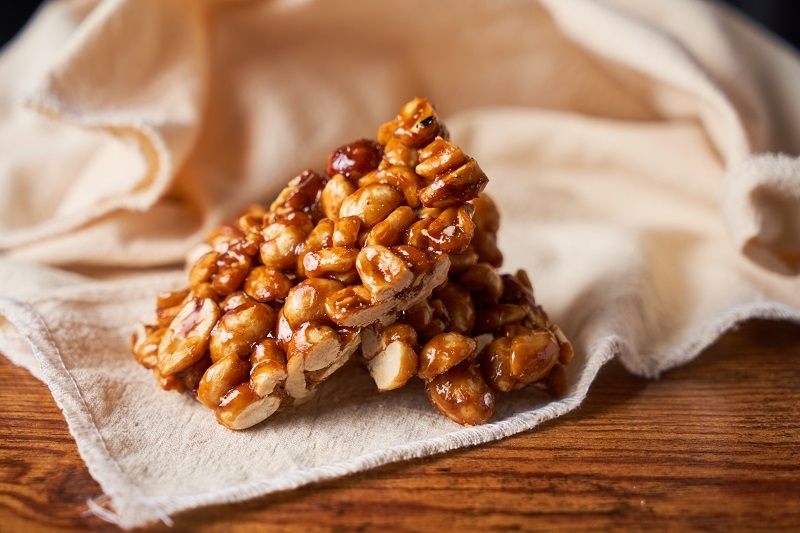
Peanut brittle is an old-fashioned candy that has been a delight to candy enthusiasts for generations. This crispy candy, crafted from caramelized peanuts and a sweet, golden-colored sugar mixture, is a holiday and special occasion staple. Peanut brittle can look like a sophisticated treat to master, but mastering the art of homemade brittle is easier than you may imagine. With the proper ingredients, equipment, and advice, you can make an easy brittle recipe that competes with any store-bought equivalent. Here, we'll discuss the fundamentals of peanut brittle, the science of its crunch, and expert advice to make your brittle come out perfectly every time.
Peanut brittle has an extensive and interesting history, with roots dating back to different cultures. A few places indicate that confections such as brittle-like foods were produced by the Celts, whereas some people feel it was developed in the Southern part of the United States in the 19th century. There is folklore, however, saying that peanut brittle was discovered unintentionally when a Southern cook misused baking soda for cream of tartar when making candy. The result turned out to be a light and airy, crispy delicacy that people soon loved with all their hearts. Peanut brittle remains a favorite holiday treat today, savored for its wonderful crunch and deep, nutty flavor.
A few ingredients are needed to prepare peanut brittle, and every ingredient is essential to achieving that desired texture and flavor:
Making homemade brittle requires a fair amount of patience, precise measurements, and following correct techniques. Whether you are just starting or are already an expert on candy making, carefully following these measures guarantees that every crunch will be the way it should. Pay attention to temperatures, for they are the essence of caramelizing the sugar well and getting that relevant snap out of the peanut brittle.
Have all equipment and ingredients ready before you begin. Get a heavy-bottomed saucepan, a candy thermometer, a wooden spoon, a heat-resistant spatula, and a baking sheet lined with parchment paper or a silicone mat. Consider having everything organized to facilitate a smooth and efficient cooking process since brittle sets quickly once it is ready.
In a medium saucepan over medium heat, mix 2 cups of sugar, 1 cup of light corn syrup, and ½ cup of water. Stir the mixture nonstop until the sugar is dissolved. After it dissolves, raise the heat to make the mixture boil. Don't stir the mixture at this point so that crystallization is avoided. Place a candy thermometer on the side of the saucepan, not touching the bottom, as this would provide a false reading. Allow the mixture to cook until it is 250°F (hard ball stage), then stir in 2 tablespoons of butter gently to incorporate.
When the sugar mixture is 300°F (hard crack stage), stir in rapidly 2 cups of raw peanuts. Take caution, as the mixture will be very hot. Stir constantly to coat the peanuts evenly and allow them to get toasted slightly within the caramelized sugar, making their nut flavor more pronounced. Add ½ teaspoon of salt and 1 teaspoon of vanilla extract at this stage to flavor the whole dish.
After peanuts are well coated, remove saucepan from heat and immediately add 1 teaspoon of baking soda. Curiously, the mixture will bubble and foam since the baking soda reacts with the caramelized sugar in it and even creates little air pockets that give the peanut brittle that light, crunchy texture. Stir quickly yet gently to distribute the baking soda evenly in it.
Gently pour the hot brittle mixture onto the lined baking sheet. Spread it thinly and evenly with a heatproof spatula. Work fast because the mixture starts to harden in a matter of seconds. Let the peanut brittle cool completely at room temperature for approximately one hour. When it is hardened, break it up into pieces and indulge in your homemade brittle.

Even seasoned candy makers encounter issues occasionally. Here are the ways to troubleshoot brittle-making issues:
Classic brittle is great on its own, but flavor experiments can add a twist to your homemade brittle. Try these fun variations:
Peanut brittle is a great homemade gift. Store it in a covered container at room temperature for two weeks to keep its crunchy texture. If you are in a humid area, add silica gel packets to the container to keep the brittle from getting soft from moisture. For gift-giving, wrap pieces separately in wax paper or put them in decorative tins or glass jars with festive ribbons. Homemade peanut brittle is not only a tasty treat but also a considerate and lovely gift for friends and loved ones.
Learning to make peanut brittle is a satisfying experience that enables you to make a tasty, crunchy candy from scratch. With a handful of simple ingredients and the proper technique, you can create homemade brittle that is easy yet impressive. Whether you're making it for yourself or as a present, peanut brittle is a classic treat that never falls out of favor. Make this easy brittle recipe and indulge in the unbeatable combination of caramelized peanuts and crunchy, golden sugar.
This content was created by AI